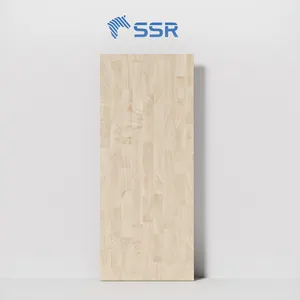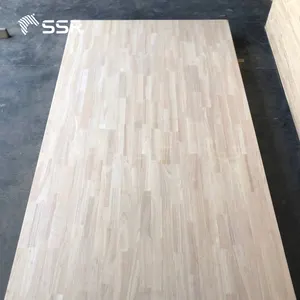
SSR VINA - Rubber Wood Hevea Finger Jointed Board - 1220x2440mm rubber wood wood board finger Jointed boards rubber joint





















Finger jointed boards are a versatile and sustainable form of engineered wood product that are widely used in construction, furniture making, and other woodworking applications. These boards are created by joining short pieces of wood together using a series of cuts that resemble interlocking fingers, which are then glued together to form longer, stronger, and more stable boards. This process not only optimizes the use of lumber, reducing waste by utilizing off-cuts and smaller pieces of timber, but also enhances the board's strength and stability by distributing the natural variations in the wood's grain throughout the entire length of the board.
The finger jointing technique is particularly appealing for businesses that prioritize both quality and environmental sustainability, as it extends the utility of timber resources and minimizes waste. Through this process, manufacturers can produce long and wide boards which maintain a uniform appearance and structural integrity, making them suitable for a variety of applications where solid wood might traditionally be used. The principles behind finger jointed boards lie in maximizing resource efficiency while providing a high-performance product that meets the aesthetic and functional needs of various industries.
For professionals in construction, interior design, cabinetry, or any field requiring high-quality wood materials, finger jointed boards offer a cost-effective and eco-friendly alternative to solid lumber. These engineered boards can be tailored to specific lengths and dimensions, providing a customizable solution for large-scale projects or specialized applications. The end result is a product that looks like solid wood but comes with the added benefits of improved stability and uniformity.
Finger jointed boards come in a variety of materials and specifications designed to meet the demands of different applications. Each type boasts unique characteristics that cater to specific requirements:
Solid Wood Finger Jointed Boards: These are made from various types of solid wood such as oak, walnut, or pine and are commonly used for furniture-making, flooring, and decorative trim due to their natural beauty and strength.
Rubberwood Finger Jointed Boards: Known for their environmental sustainability, rubberwood boards are a popular choice for eco-conscious projects. They’re often employed in furniture manufacturing because of their smooth grain and ease of finishing.
Acacia Finger Jointed Boards: Acacia is prized for its durability and attractive grain patterns. These boards are suitable for heavy-duty use such as in countertops or outdoor furniture.
Plywood Finger Jointed Boards: Plywood variants have layers of veneer joined with finger joints at the edges. They are ideal for construction applications where broad, flat surfaces are needed.
Poplar Finger Jointed Boards: Lightweight yet strong, poplar is an excellent choice for interior mouldings and millwork where a fine finish is desired.
Each type offers specific advantages depending on the project requirements such as visual appeal, weight considerations, durability against wear or weather conditions, ease of machining, or cost-effectiveness.
Selecting the appropriate finger jointed boards for your business project involves a careful consideration of several factors to ensure they match your specific needs:
Material Composition: Assess the type of wood material that best suits your project. For instance, choose hardwood finger jointed boards like oak or acacia if durability is paramount or opt for softwood like pine if you're looking for lighter weight options.
Application: Consider where the board will be used—whether it's for indoor or outdoor use, structural purposes or aesthetic finishes. For outdoor applications or areas exposed to moisture, look for materials that have natural resistance to decay or those that are treated to withstand these conditions.
Design Style: Align your choice with the design style you're targeting. Modern styles may prefer clean lines and minimalist grains offered by rubberwood or poplar, while traditional settings might call for the rich textures found in walnut or oak.
Structural Use: Determine if the board needs to provide structural support. Certain finger jointed boards come with enhanced load-bearing capabilities suitable for construction purposes.
Surface Treatment: Decide on pre-finished boards with treatments like priming or varnishing if you're looking to save time during installation; otherwise, untreated options offer more flexibility for custom finishes.
When it comes to sourcing finger jointed boards for your business needs, Alibaba.com stands out as a global marketplace connecting buyers with reputable suppliers from around the world. With an extensive selection across multiple categories including construction materials and furniture manufacturing supplies, Alibaba.com ensures you can find exactly what you need for any project scope or scale.
The platform's user-friendly interface allows you to filter through an array of options based on material type, application use-case, design style preferences, structural requirements and more—tailoring your search effectively to your specific demands. Furthermore, Alibaba.com's commitment to facilitating smooth transactions through services like Trade Assurance instills confidence that your order will be handled securely until delivery is complete.
By choosing Alibaba.com for your wholesale finger jointed board needs, you access an unparalleled diversity of products from global suppliers while enjoying features designed to simplify the buying process. Whether you're outfitting apartments with elegant trims or crafting robust furniture pieces for retail sale, Alibaba.com empowers your business to source quality materials efficiently and cost-effectively—helping you stay competitive in today's market.
Finger jointed boards offer enhanced stability and uniformity, which reduces the likelihood of warping and shrinkage. They are also an eco-friendly option that maximizes the use of wood off-cuts, making them a cost-effective alternative to solid lumber.
Some finger jointed boards are engineered to provide structural support and can be used in load-bearing applications. It is important to confirm the structural capabilities of the specific board type with the supplier to ensure it meets the requirements of your project.
Certain types of finger jointed boards are suitable for outdoor use, especially those made from woods with natural decay resistance or those that are properly treated for exterior conditions. Material choice and treatment are critical factors for outdoor applications.
For furniture making, consider factors such as the desired aesthetic, strength requirements, and the type of finish you plan to apply. Hardwood finger jointed boards like oak or walnut offer durability and a rich appearance, while softer woods like pine may be preferable for lightweight furniture.
Finger jointed boards can complement a range of design styles depending on their wood type and finish. For example, modern designs might favor the clean lines of rubberwood or poplar, while traditional settings may opt for the classic look of oak or walnut.
Yes, many finger jointed boards are made from sustainable sources or utilize wood by-products, making them an eco-friendly option. Rubberwood boards, in particular, are known for their environmental sustainability.
Many suppliers on Alibaba.com offer customization options for dimensions and finishes according to your project requirements. It is advisable to discuss your specifications directly with suppliers to ensure they can meet your needs.
To ensure quality when ordering in bulk, look for suppliers on Alibaba.com who offer detailed product descriptions, high-quality images, certifications, and customer reviews. Additionally, consider utilizing Alibaba.com's Trade Assurance service for added protection.
Lead times can vary depending on the supplier's location, order quantity, and customization requirements. It's important to communicate with suppliers on Alibaba.com to establish clear timelines before placing an order.
Packaging for shipping typically involves protective wrapping and secure palletizing to prevent damage during transit. Specific packaging methods should be confirmed with the supplier prior to shipment.
Like any wood product, finger jointed boards may require regular maintenance such as cleaning and occasional refinishing depending on their use and exposure to environmental factors. Always follow care instructions provided by the manufacturer.
Look for certifications related to sustainability (such as FSC or PEFC), formaldehyde emission standards (like E0, E1, E2), and any other industry-specific certifications that attest to the quality and environmental standards of the wood products.